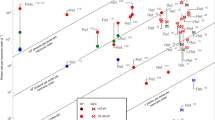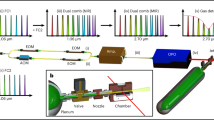Abstract
The control of the broadband frequency comb1 emitted from a mode-locked femtosecond laser has permitted a wide range of scientific and technological advances—ranging from the counting of optical cycles for next-generation atomic clocks1,2 to measurements of phase-sensitive high-field processes3. A unique advantage of the stabilized frequency comb is that it provides, in a single laser beam, about a million optical modes with very narrow linewidths4 and absolute frequency positions known to better than one part in 1015 (ref. 5). One important application of this vast array of highly coherent optical fields is precision spectroscopy, in which a large number of modes can be used to map internal atomic energy structure and dynamics6,7. However, an efficient means of simultaneously identifying, addressing and measuring the amplitude or relative phase of individual modes has not existed. Here we use a high-resolution disperser8,9 to separate the individual modes of a stabilized frequency comb into a two-dimensional array in the image plane of the spectrometer. We illustrate the power of this technique for high-resolution spectral fingerprinting of molecular iodine vapour, acquiring in a few milliseconds absorption images covering over 6 THz of bandwidth with high frequency resolution. Our technique for direct and parallel accessing of stabilized frequency comb modes could find application in high-bandwidth spread-spectrum communications with increased security, high-resolution coherent quantum control, and arbitrary optical waveform synthesis10 with control at the optical radian level.
This is a preview of subscription content, access via your institution
Access options
Subscribe to this journal
Receive 51 print issues and online access
$199.00 per year
only $3.90 per issue
Buy this article
- Purchase on Springer Link
- Instant access to full article PDF
Prices may be subject to local taxes which are calculated during checkout




Similar content being viewed by others
References
Udem, T., Holzwarth, R. & Hansch, T. W. Optical frequency metrology. Nature 416, 233–237 (2002)
Diddams, S. A. et al. An optical clock based on a single trapped 199Hg+ ion. Science 293, 825–828 (2001)
Baltuska, A. et al. Attosecond control of electronic processes by intense light fields. Nature 421, 611–615 (2003)
Bartels, A., Oates, C. W., Hollberg, L. & Diddams, S. A. Stabilization of femtosecond laser frequency combs with subhertz residual linewidths. Opt. Lett. 29, 1081–1083 (2004)
Oskay, W. H. et al. Single-atom optical clock with high accuracy. Phys. Rev. Lett. 97, 020801 (2006)
Marian, A., Stowe, M. C., Lawall, J. R., Felinto, D. & Ye, J. United time-frequency spectroscopy for dynamics and global structure. Science 306, 2063–2068 (2004)
Gerginov, V., Tanner, C. E., Diddams, S. A., Bartels, A. & Hollberg, L. High-resolution spectroscopy with a femtosecond laser frequency comb. Opt. Lett. 30, 1734–1736 (2005)
Shirasaki, M. Large angular dispersion by a virtually imaged phased array and its application to a wavelength demultiplexer. Opt. Lett. 21, 366–368 (1996)
Xiao, S. & Weiner, A. M. 2-D wavelength demultiplexer with potential for ≥ 1000 channels in the C-band. Opt. Express 12, 2895–2901 (2004)
Jiang, Z., Seo, D. S., Leaird, D. E. & Weiner, A. M. Spectral line-by-line pulse shaping. Opt. Lett. 30, 1557–1559 (2005)
Baklanov, Y. V. & Chebotayev, V. P. Narrow resonances of two-photon absorption of super-narrow pulses in a gas. Appl. Phys. 12, 97–99 (1977)
Teets, R., Eckstein, J. & Hänsch, T. W. Coherent two-photon excitation by multiple light pulses. Phys. Rev. Lett. 38, 760–764 (1977)
Jones, D. J. et al. Carrier-envelope phase control of femtosecond mode-locked lasers and direct optical frequency synthesis. Science 288, 635–639 (2000)
Lepetit, L., Cheriaux, G. & Joffre, M. Linear techniques of phase measurement by femtosecond spectral interferometry for applications in spectroscopy. J. Opt. Soc. Am. B 12, 2467–2474 (1995)
Bartels, A. & Kurz, H. Generation of a broadband continuum by a Ti:sapphire femtosecond oscillator with a 1-GHz repetition rate. Opt. Lett. 27, 1839–1841 (2002)
Ramond, T. M., Diddams, S. A., Hollberg, L. & Bartels, A. Phase-coherent link from optical to microwave frequencies by means of the broadband continuum from a 1-GHz Ti:sapphire femtosecond oscillator. Opt. Lett. 27, 1842–1844 (2002)
Wang, S. X., Xiao, S. & Weiner, A. M. Broadband, high spectral resolution 2-D wavelength-parallel polarimeter for dense WDM systems. Opt. Express 13, 9374–9380 (2005)
Jenkins, F. A. & White, H. E. Fundamentals of Optics 4th edn (McGraw Hill, New York, 1976)
Quinn, T. J. Practical realization of the definition of the metre, including recommended radiations of other optical frequency standards (2001). Metrologia 40, 103–133 (2003)
Kato, H. Doppler-Free High Resolution Spectral Atlas of Iodine Molecule 15000 to 19000 cm-1 (Japan Society for the Promotion of Science, Tokyo, 2000)
Thorpe, M. J., Moll, K. D., Jones, R. J., Safdi, B. & Ye, J. Broadband cavity ringdown spectroscopy for sensitive and rapid molecular detection. Science 311, 1595–1599 (2006)
Simonsen, H. R. & Rose, F. Absolute measurements of the hyperfine splittings of six molecular 127I2 around the He-Ne/I2 wavelength at λ≈633 nm. Metrologia 37, 651–658 (2000)
Acknowledgements
We thank A. M. Weiner for discussions about the VIPA spectrometer, and J. Ye for discussions that motivated our application of frequency combs to broadband spectroscopy. We further thank J. Stalnaker and Y. LeCoq for their comments on this manuscript, and H. Kato for the CW iodine spectroscopy data. This paper is a contribution of the National Institute of Standards and Technology, with partial support from DARPA.
Author information
Authors and Affiliations
Corresponding author
Ethics declarations
Competing interests
Reprints and permissions information is available at www.nature.com/reprints. The authors declare no competing financial interests.
Rights and permissions
About this article
Cite this article
Diddams, S., Hollberg, L. & Mbele, V. Molecular fingerprinting with the resolved modes of a femtosecond laser frequency comb. Nature 445, 627–630 (2007). https://doi.org/10.1038/nature05524
Received:
Accepted:
Issue Date:
DOI: https://doi.org/10.1038/nature05524
This article is cited by
-
A Review of a Spectral Domain Interferometer with a Frequency Comb for Length Measurement
International Journal of Precision Engineering and Manufacturing (2024)
-
Massively parallel electro-optic sampling of space-encoded optical pulses for ultrafast multi-dimensional imaging
Light: Science & Applications (2023)
-
Quantum enhanced measurement of an optical frequency comb
npj Quantum Information (2021)
-
1.3 µm dissipative soliton resonance generation in Bismuth doped fiber laser
Scientific Reports (2021)
-
Photon-counting distributed free-space spectroscopy
Light: Science & Applications (2021)
Comments
By submitting a comment you agree to abide by our Terms and Community Guidelines. If you find something abusive or that does not comply with our terms or guidelines please flag it as inappropriate.



